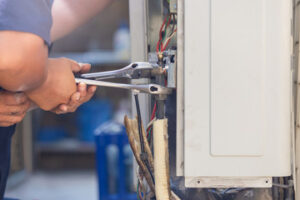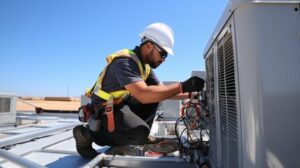If your furnace produces unusual noises, a professional service technician can diagnose and fix the problem. For example, banging and whining sounds may be caused by a dirty blower or thermostat problems. Contact Furnace Repair Houston for professional help.

A puddle next to your furnace might be a sign of a water leak. This can be a simple repair, but it’s important to address it immediately.
The burners in your furnace create a flame that ignites gas and heats the air in your home. If this burner is clogged with dust, debris, or carbon it won’t ignite properly and your system will be less efficient. This means you’ll need to use more energy to warm your house and may even experience unexpected furnace problems. If you think your furnace burner is dirty, a professional technician should inspect and clean it to prevent serious issues.
The first sign of dirty burners is typically increased furnace noise. This increased noise may be heard throughout your home through ductwork, registers, and vents. It is a result of the burning of excess dirt, which narrows the air passage in the combustion chamber and increases air flow resistance.
In severe cases, heavily clogged burners can stop the furnace from firing at all. This is a fire hazard and can leave you without heating during cold weather. Oftentimes, a clogged burner will emit strange odors, such as a burning smell or oily scent.
Other signs of dirty burners include a lack of heat in certain rooms, rapid changes in thermostat temperatures, and an increase in heating utility bills. Dirty burners reduce the efficiency of your system, causing it to work harder and take longer to reach the desired temperature.
To clean your burners, shut off the power to the furnace by turning off its breaker or locating and closing the gas valve. You’ll also need to turn off the blower fan in order to safely access the burners. Once you’ve turned off the power and shut off the gas, remove the furnace access panel to expose the burners. You should then use a brush or vacuum cleaner attachment to remove any visible dirt or debris. Be sure to wear protective equipment as some of the debris could be rusty or broken glass.
Once you’ve removed any debris, be sure to replace the access panel and test the burners. If they are still dirty, you can repeat the process until they are completely cleaned. After your burners are clean, reassemble the furnace and be sure to restart the system. Check the burners for a blue flame to ensure that they are functioning properly.
Dirty Air Ducts
Dirty air ducts contribute to poor indoor air quality. Dust mites, pet dander, and other allergens collect in clogged air ducts over time and are then circulated throughout the house. These allergens trigger asthma and other respiratory issues in many families. They also promote the development of lower respiratory infections like bronchitis and pneumonia.
If you or any of your family members suffer from asthma, you should make sure your air ducts are cleaned regularly. If you have children with asthma, this is even more important since clogged air ducts can cause an increased severity of symptoms in these kids.
Clogged air ducts can also interfere with the function of your home heating and cooling system. This is because they prevent the efficient circulation of heated or cooled air, which can lead to higher energy bills and less comfort in your home.
Another sign that your air ducts need cleaning is if you see a lot of dust around your vents. This is because clogged vents allow dirt and other debris to build up faster than normal, which can interfere with the airflow of your heating or cooling system.
You should also check the ductwork for signs of mold or mildew. Mold spores can cause severe allergies and respiratory distress in some people, so they should be removed promptly. Air ducts that are damp or humid are also a breeding ground for mold.
Other signs that your air ducts need cleaning include if you notice that the airflow through your vents is slower than usual or that some rooms are warmer or cooler than others. This is because the dirty air ducts are preventing the proper circulation of warm or cold air, which causes your HVAC system to work harder and can result in higher energy bills.
If you have guests in your home, they may notice a musty smell coming from the vents or in the room. This odor is caused by the growth of mildew and mold in the ductwork, and it can be difficult to get rid of. If you can’t remove the odor, it’s best to call a professional air duct cleaning company as soon as possible.
Thermostat Issues
A properly functioning thermostat is crucial to a comfortable home. When issues arise with this device, it can disrupt your HVAC system and lead to costly repairs. Fortunately, there are many common thermostat problems that can be solved easily through simple methods like replacing batteries or ensuring all wiring and fuses are intact. If these fixes don’t work, however, it may be time to call in a professional.
A faulty thermostat can affect your furnace in a number of ways, including preventing it from turning on when you need it to heat your home. This is a sign that the device isn’t getting power and needs to be reset or replaced. This issue can also stem from a bad or outdated air filter. If you haven’t replaced your filter in a while, installing a new one could solve the problem.
Another common issue with thermostats is the symptom of turning off and on frequently, which is known as short-cycling. This can be caused by a variety of issues, including a dirty air filter or a thermostat that doesn’t respond to your settings. A thermostat that isn’t responding to your settings can also cause the heating system to run on a pre-selected schedule or set for the wrong type of equipment, leading to unnecessary wear and tear.
In most cases, a thermostat that isn’t working is the result of an electrical problem. If your thermostat uses batteries, check the low-battery indicator light to see if it is illuminated. If it isn’t, you can try replacing the batteries or pressing the recessed reset button using a paperclip (if there is one) to restart the unit. If the unit still isn’t responsive, check the furnace switch to make sure it is in the on position.
Similarly, a hardwired thermostat that’s not receiving power can be the result of a tripped or blown fuse. Make sure the HVAC breaker is on and that all fuses are in place and good condition. If the issue persists, a professional should examine the circuit board and electrical connections to determine what’s causing it to not turn on.
Gas Leaks
Gas leaks from your furnace can be incredibly dangerous. This is why it is important that you know how to spot the signs of a gas leak, and what to do when you encounter one.
The most common cause of a gas leak from your furnace is that the heat exchanger has a crack or rust hole in it. When this happens, your furnace will start leaking carbon monoxide. This is a very toxic gas, so it is important that you have it fixed right away.
Another reason you might have a gas leak is that the blower motor has failed. When this occurs, it will no longer blow air over the heat exchanger, and instead, will blow it into your ducts. This can lead to a number of different problems, including excess moisture in your ducts. It can also lead to the formation of mold and mildew. If you have any of these issues, it is important to contact a professional heating technician to inspect and repair them.
A clogged drain line is another common problem that can trigger a gas leak from your furnace. Some high efficiency furnaces have a pump that is used to lift condensation from the heat exchanger and transfer it into the drain system. Over time, this can become clogged with debris, or the condensation pump may fail. Replacing this part can be difficult, and it is a job best left to professionals.
Other causes of a gas leak are problems with the gas line itself, or the line connecting your furnace to the home. For example, tree roots can grow into the gas line over time and cut off the flow of gas. Other problems include contaminants in the line, damage to the line, or a build-up of gunk at the gas line access point.
The most common sign of a gas leak is the smell. Natural gas doesn’t have an odor, so producers add in a rotten egg-like stench for safety. If you can smell gas in your home, evacuate immediately and call the gas company and emergency services.
